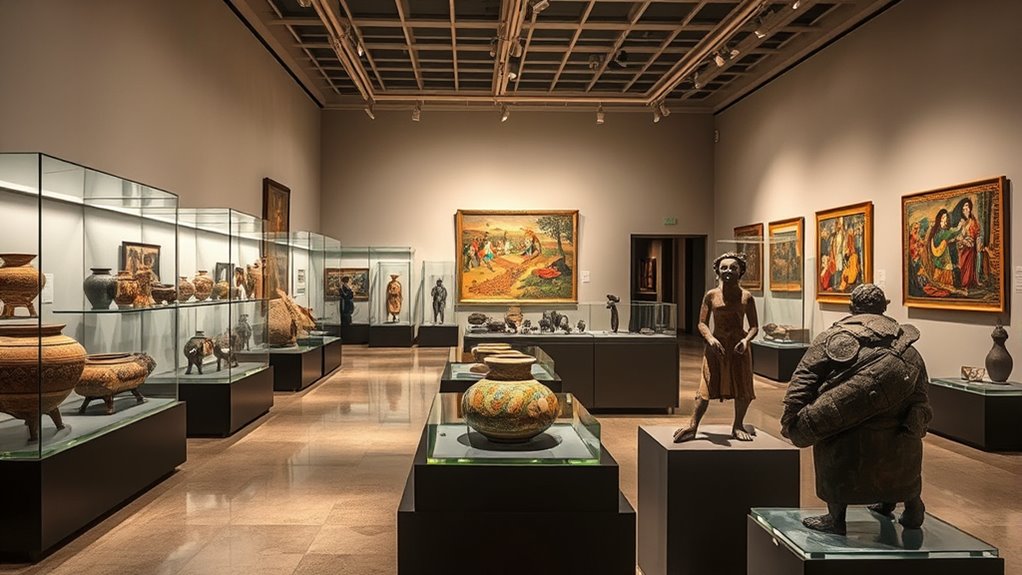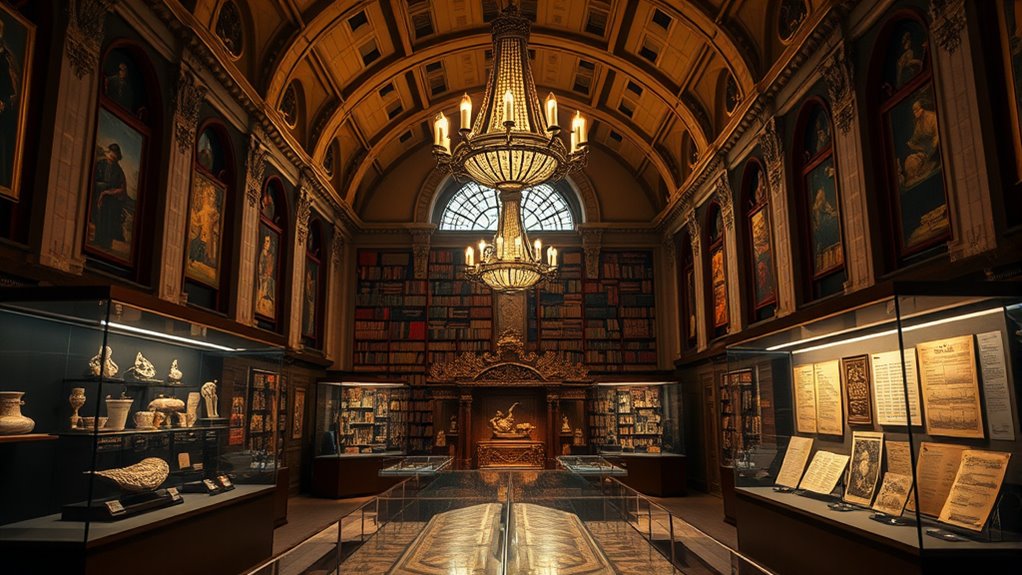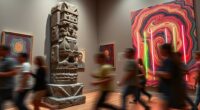Museums and galleries serve as guardians of cultural heritage by conserving artifacts, promoting diversity, and engaging communities. They protect tangible and intangible traditions through careful preservation techniques, environmental controls, and digital technologies. Despite challenges like funding shortages and workforce gaps, their roles support social cohesion, boost local economies, and foster understanding. To learn how these institutions sustain our shared history and future, explore the essential strategies and benefits they offer.
Key Takeaways
- Museums and galleries act as custodians by conserving artifacts and safeguarding intangible heritage through research, restoration, and environmental controls.
- They utilize specialized techniques and digital tools to ensure the long-term preservation of delicate materials and cultural artifacts.
- Museums promote cultural diversity and representation, addressing underrepresentation through diverse collections and inclusive programs.
- They face challenges like limited funding, workforce shortages, and outdated infrastructure, requiring innovative solutions and sustainable practices.
- Preserving cultural heritage through museums supports community engagement, economic growth, social cohesion, and intergenerational storytelling.
The Vital Role of Museums and Galleries in Cultural Preservation

Museums and galleries play an essential role in preserving cultural heritage by acting as trusted custodians of artifacts and traditions. You rely on them to safeguard tangible heritage, ensuring future generations can experience history firsthand. They do this through conservation, research, and restoration efforts that maintain the integrity of artworks and objects. Environmental controls protect artifacts from deterioration caused by humidity, light, and temperature. Preservation isn’t limited to physical items; museums also safeguard intangible heritage like rituals, oral histories, and traditions. By collecting diverse artifacts from different eras and regions, they promote cultural diversity. These institutions serve as guardians, ensuring that both material and intangible cultural expressions are preserved, respected, and passed on, keeping the rich tapestry of human history alive and accessible. Implementing specialized techniques ensures that delicate textiles and artifacts are maintained in optimal conditions for future study and appreciation. Additionally, ongoing educational programs help raise awareness about the importance of cultural preservation among the public, emphasizing the significance of cultural heritage management in sustaining our collective history. Incorporating community engagement initiatives can also strengthen local connections to heritage and foster a shared sense of responsibility. Engaging with these institutions can also foster a deeper understanding of the importance of attention in preservation, ensuring that every detail is carefully considered for long-term sustainability.
The Scope and Diversity of Heritage Collections

The scope and diversity of heritage collections reveal both the richness and the gaps within our cultural record. You’ll notice that major U.S. museums primarily feature white, male artists—85% of artists are white, and 87% are male—highlighting significant underrepresentation of women and artists of color. Only about 11% of acquisitions are works by female artists, and Black American artists remain underrepresented. Some institutions, like the High Museum of Art, showcase more Black and African American artists, while others focus on Hispanic/Latinx creators. This lack of diversity surpasses population demographics, which are 61% white and 50.2% male. Museums are actively addressing these gaps by deaccessioning works and guided by data-driven benchmarks, aiming to build collections that better reflect society’s true diversity and cultural narratives. For example, the use of diversity benchmarks helps museums evaluate and improve their collections strategically. Additionally, many institutions are now incorporating representation data to better understand and close these gaps. Incorporating DEI initiatives can further support efforts to diversify collections and ensure equitable representation across all cultural narratives.
Challenges Facing Preservation and Conservation Efforts

You face significant hurdles when resources are limited and funding falls short of needs, making it hard to maintain and protect heritage sites. Skilled staff shortages and outdated infrastructure further challenge your efforts, slowing down conservation projects. Without adequate support, preserving our cultural treasures becomes an increasingly difficult task. The global spread of museums and their role in shaping cultural narratives often divert attention and resources away from local preservation priorities. Additionally, the lack of effective space utilization can hinder the organization and storage of artifacts, further complicating preservation tasks. Incorporating innovative planting designs and sustainable materials can optimize space and enhance preservation environments. Developing a deeper understanding of traditional building techniques can also contribute significantly to sustainable conservation practices. Moreover, leveraging modern preservation technologies can improve conservation accuracy and efficiency, ensuring long-term protection of heritage assets. Implementing ethical hacking principles in digital preservation efforts can safeguard sensitive digital records against cyber threats, ensuring ongoing access and integrity of digital cultural collections.
Funding and Resource Gaps
Why do so many preservation efforts struggle to secure adequate funding? Limited public and private resources are a key reason. Globally, the median expenditure per person on cultural heritage is only about $89, and 40% of U.S. institutions allocate no funds for collection care. Few institutions have dedicated endowments, and many don’t prioritize preservation in their budgets. Federal grants, like the U.S. Historic Preservation Fund, see high demand—over $1.86 requested for every dollar available—yet only about a quarter of applicants receive funding. Most institutions rely on matching funds, which adds to the challenge. Without consistent, dedicated budgets, preservation remains an afterthought, risking long-term degradation. Additionally, craft and textiles play a vital role in cultural expression and identity, yet they often receive less funding for preservation compared to other types of artifacts. This underfunding leads to deterioration of delicate materials, which are especially vulnerable without proper conservation measures. Moreover, increasing awareness and advocacy are essential to motivate more robust support for these preservation priorities across communities and policymakers. Implementing targeted funding strategies can help ensure that resources are allocated effectively. Strengthening public engagement can help highlight the importance of conserving diverse cultural heritage.
Skill Shortages and Infrastructure
Addressing preservation challenges requires skilled workers, yet there’s a looming shortage of qualified professionals in heritage sectors. Over 68% of employers expect skills shortages by 2028, and 71% of Scottish traditional housing needs urgent repairs, highlighting this gap. You’ll find that 10,000 new heritage jobs are projected in Scotland alone over the next decade, but attracting young talent remains critical. Many traditional craft skills are at risk of extinction, with nearly half of heritage businesses concerned about craft shortages. Workforce proficiency issues persist, with 11% of firms reporting skills gaps and over 1% of jobs vacant due to shortages. To meet future demands, investments in training, digital skills, and regional programs are essential, especially as many skilled practitioners approach retirement, risking further losses. Particularly concerning is the fact that only 6% of key traditional skills have formal training programs in place, underscoring the urgent need to develop comprehensive education pathways. Furthermore, integrating AI-driven learning platforms could help bridge the skills gap by providing accessible training resources for aspiring heritage professionals. Additionally, promoting awareness of heritage preservation careers can attract more young talent to this vital field. Recognizing the importance of skilled craftsmanship in maintaining cultural identity is crucial for sustainable preservation efforts. Building public engagement can also foster greater appreciation and support for heritage initiatives.
Strategies to Strengthen Cultural Heritage Safeguards

To effectively strengthen cultural heritage safeguards, implementing thorough strategies that combine preventive conservation, technological innovation, community involvement, and risk management is essential. You should control environmental factors like temperature (16°C–20°C) and humidity (40%–60%) to prevent deterioration, while minimizing light exposure to protect sensitive materials. Regular monitoring helps detect issues early. Embracing digital preservation techniques, such as 3D scanning, VR, AR, and digital archiving, enhances artifact protection and accessibility. Engaging communities and fostering collaborations ensure preservation respects cultural diversity. Additionally, developing risk management policies, like climate change adaptation, emergency plans, and staff training, shields artifacts from disasters. Utilizing advanced materials and adhering to international standards further strengthens your safeguarding efforts, guaranteeing the longevity of cultural heritage for future generations.
Economic and Social Benefits of Preserving Heritage

Preserving cultural heritage strengthens your community’s identity and fosters social cohesion among residents. It also boosts local economies by attracting tourists and generating job opportunities. These benefits show how safeguarding heritage creates lasting value for both society and the economy.
Cultural Identity and Community Cohesion
Cultural heritage plays a pivotal role in strengthening community bonds and fostering a shared identity, which in turn boosts social cohesion. When you participate in preservation projects, you help create spaces for social interaction and cooperation, building a sense of ownership and pride. Heritage activities encourage intergenerational dialogue, sharing stories and traditions that connect different age groups. Museums and galleries serve as community hubs, hosting cultural events and educational programs that unite people. The table below highlights key ways heritage enhances community cohesion:
| Method | Impact |
|---|---|
| Volunteering | Builds social networks and skills sharing |
| Heritage Sites | Act as gathering places for social events |
| Cultural Programs | Promote understanding and reduce prejudice |
| Community Projects | Strengthen bonds and foster shared pride |
Economic Growth and Tourism
Heritage sites attract tourists and boost local economies, making cultural preservation a key driver of economic growth. When you visit these sites, you contribute to the $123.6 billion spent annually by cultural heritage travelers, creating jobs in tourism and related sectors. Your visits also support infrastructure development, benefiting both tourists and residents. Heritage tourism encourages innovation and business diversification, helping small businesses thrive within historic settings. The revenue generated from tourism, through taxes and sales, funds ongoing preservation efforts, ensuring sites remain attractive. As communities embrace heritage tourism, they experience increased pride and economic stability. This growth fosters new opportunities, supporting local economies and strengthening the social fabric. Preserving heritage isn’t just about culture; it’s an essential component of economic prosperity.
Policy and Funding: Ensuring Future Sustainability

Ensuring the long-term sustainability of museums requires a strategic approach to policy and funding, especially as government support faces growing challenges. Currently, government funding accounts for only 24% of museum income, with local governments providing most of that (13%), followed by state (8%) and federal (3%). While federal support is small, it’s crucial for major institutions like the National Gallery of Art, which relies on public-private partnerships to operate. However, state and local funding face volatility, with state arts appropriations expected to drop by 10% in 2025. To guarantee future resilience, you must advocate for diversified revenue streams, strengthen public-private partnerships, and push for sustained federal and state investment. Embracing innovative policies is key to securing museums’ cultural and educational roles long-term.
Frequently Asked Questions
How Do Museums Prioritize Which Items to Preserve?
You prioritize items based on their impact, condition, and importance to your organization. Rarity and historical significance also matter, especially if an item is essential for your mission. You assemble a knowledgeable team, assess resources, and consider urgency to make decisions. Grouping similar items helps streamline efforts. Regular assessments and emergency plans ensure you’re prepared to act quickly, focusing on high-impact preservation activities first.
What Technological Innovations Are Helping in Conservation Efforts?
Imagine you’re using 3D laser scanning to restore an ancient monument. This innovation captures precise, scalable digital replicas, helping conservators plan repairs without risking the original. Technologies like laser scanning, LiDAR, and photogrammetry enable detailed documentation and virtual reconstruction, making conservation more accurate and less invasive. These tools allow you to monitor site conditions in real-time, ensuring long-term preservation and better public engagement through digital models and immersive experiences.
How Can Communities Participate in Cultural Heritage Preservation?
You can participate in cultural heritage preservation by engaging in community meetings and workshops to share your insights. Volunteer for local programs, join advisory committees, or help with asset mapping to identify important sites. Participating in surveys and feedback sessions allows your voice to influence conservation efforts. By being actively involved, you help foster cultural continuity, strengthen community support networks, and guarantee preservation aligns with local values.
What Are the Biggest Threats to Cultural Collections Today?
You face many threats to cultural collections today. Armed conflicts can cause irreparable damage or theft, while natural disasters like fires and floods threaten fragile artifacts. Urbanization and tourism put pressure on sites, risking deterioration. Limited funding hampers preservation efforts, making it harder to protect collections effectively. Climate change accelerates decay, and illicit trafficking endangers valuable items. Staying vigilant and supporting preservation initiatives helps safeguard your cultural heritage for future generations.
How Do Museums Balance Public Access With Preservation Needs?
You might think unlimited access is ideal, but museums know that balancing public viewing with preservation is essential. They carefully rotate exhibits, control environmental conditions, and limit visitor numbers to prevent damage. Digital tools like virtual tours and 3D models help you explore collections without risking the originals. By combining strict protocols with innovative technology, they guarantee you can enjoy art and history today while safeguarding it for tomorrow.
Conclusion
By supporting museums and galleries, you’re helping to keep cultural heritage alive like a vibrant tapestry woven through time. Your involvement ensures these treasures are preserved for future generations, enriching our collective story. Think of these institutions as guardians of identity, holding history’s keys in their hands. Together, we can keep the cultural flame burning bright, lighting the way for others to discover and cherish the rich legacy that makes us who we are.










